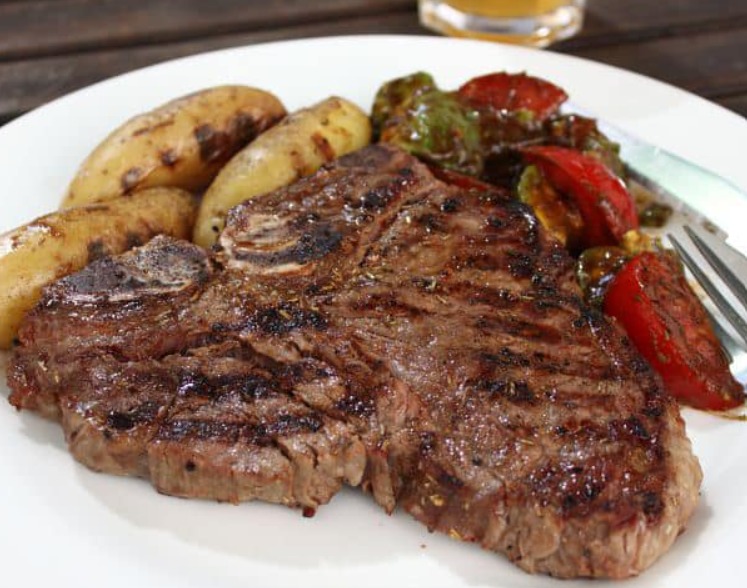
Reverse Seared T-Bone Steak, a culinary masterpiece revered for its succulent tenderness and mouthwatering flavor, represents the epitome of steak perfection. This method of cooking, which involves gently roasting the steak before searing it to a caramelized crust, has revolutionized the way steak enthusiasts approach the art of grilling. Delving into its rich history unveils a tale of culinary innovation, while exploring its benefits reveals a treasure trove of juicy indulgence and epicurean delight. Here, we embark on a journey to uncover the irresistible charm, numerous benefits, and the art of mastering Reverse Seared T-Bone Steak.
History:
The history of cooking steak is as old as civilization itself, with evidence of grilled meats dating back to ancient times. However, the concept of reverse searing—a method that involves slow-roasting the meat before applying a high-heat sear—emerged relatively recently in the world of barbecue and grilling.
While the exact origins of reverse searing are unclear, it gained popularity in the late 20th and early 21st centuries among barbecue enthusiasts and professional chefs seeking to achieve the perfect balance of tenderness and flavor in their steaks. The method was popularized by chefs and pitmasters who recognized the benefits of gently cooking the steak to the desired internal temperature before searing it to perfection.
Reverse searing is particularly well-suited for thick cuts of steak, such as T-bone, ribeye, or porterhouse, allowing for precise control over the cooking process and resulting in evenly cooked meat with a beautifully seared crust.
Benefits:
- Perfectly Cooked Steak: Reverse searing allows for precise control over the cooking process, ensuring that the steak is cooked to the desired level of doneness from edge to edge. By gently roasting the steak at a low temperature before searing it over high heat, you can achieve a tender, evenly cooked interior with a caramelized crust.
- Enhanced Flavor Development: Slow-roasting the steak allows the natural juices and flavors to mingle and develop, resulting in a steak that is bursting with succulent tenderness and rich flavor. The gentle cooking process helps to break down connective tissue and fat, resulting in a steak that is juicy and flavorful.
- Beautifully Seared Crust: After slow-roasting the steak to the desired internal temperature, a quick sear over high heat creates a beautifully caramelized crust that adds depth and complexity to the flavor profile. The Maillard reaction, which occurs when proteins and sugars react under high heat, creates delicious browning and flavor compounds that enhance the overall taste experience.
- Versatility: Reverse searing is a versatile cooking method that can be adapted to a variety of cuts and thicknesses of steak. Whether you prefer T-bone, ribeye, or porterhouse, the reverse searing technique allows you to achieve perfect results every time, regardless of the size or shape of the steak.
Ingredients:
- 2 T-bone steaks, about 1 to 1 1/2 inches thick
- Kosher salt
- Freshly ground black pepper
- Optional: your favorite steak seasoning or rub
Instructions:
- Preheat the Oven: Preheat your oven to 250°F (120°C). This low temperature will gently cook the steak to the desired internal temperature without overcooking the exterior.
- Season the Steak: Season the T-bone steaks generously on both sides with kosher salt and freshly ground black pepper. You can also use your favorite steak seasoning or rub for additional flavor.
- Slow-Roast the Steak: Place the seasoned steaks on a wire rack set over a baking sheet and transfer them to the preheated oven. Roast the steaks until they reach an internal temperature of about 10-15°F below your desired final temperature. This will vary depending on your preference for doneness (e.g., rare, medium-rare, medium).
- Sear the Steak: Once the steaks have reached the desired internal temperature, remove them from the oven and let them rest for a few minutes while you preheat a cast iron skillet or grill pan over high heat. Sear the steaks for 1-2 minutes on each side, or until a deep golden-brown crust forms.
- Rest and Serve: Remove the reverse-seared T-bone steaks from the skillet and let them rest for 5-10 minutes before slicing. This allows the juices to redistribute and ensures a tender, juicy steak. Slice the steaks against the grain and serve immediately with your favorite side dishes.

Conclusion:
Reverse Seared T-Bone Steak represents the pinnacle of steak perfection, combining tender, evenly cooked meat with a beautifully caramelized crust. With its rich history, numerous benefits, and versatility, this culinary masterpiece has earned its place as a beloved favorite among steak enthusiasts and grill masters alike. By mastering the art of reverse searing, you can elevate your steak game to new heights and savor the incomparable pleasure of a perfectly cooked T-bone steak, each and every time.